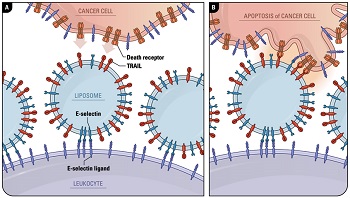 |
| White blood cells hold the compound with TRAIL proteins that kill cancer cells upon contact.--Courtesy of Cornell |
Like any moving target, metastatic cancer is notoriously difficult to treat. One of the major hurdles in cancer research is the detection of cancer cells that have spread in the body, but researchers at Cornell have developed a compound that could piggyback on white blood cells and deliver cancer-killing drugs very effectively throughout the body.
The Cornell University engineers used two proteins to create what resembles a sticky bomb for cancer cells. The tumor necrosis factor related apoptosis-inducing ligand (TRAIL) is a protein that induces cell death in cancer cells when it comes in contact with their surfaces. And to get it to hitch a ride with the white blood cells, or leukocytes, which are everywhere in the bloodstream, they used an adhesive protein called E-selectin.
The team published their findings Jan. 6 in the journal Proceedings of the National Academy of Sciences, calling these armed leukocytes "unnatural killer cells."
"The mechanism is surprising and unexpected in that this repurposing of white blood cells in flowing blood is more effective than directly targeting the cancer cells with liposomes or soluble protein," the authors said, as reported by the university's Cornell Chronicle.
In very early tests in a saline solution, the protein compound showed a 60% success rate in killing cancer cells, according to the report. But when applied to flowing blood in vitro, allowing the compound to adhere to white blood cells, the success rate jumped to 100%.
"These circulating cancer cells are doomed," lead author Michael King told the Chronicle. "About 90% of cancer deaths are related to metastases, but now we've found a way to dispatch an army of killer white blood cells that cause apoptosis--the cancer cell's own death--obliterating them from the bloodstream. When surrounded by these guys, it becomes nearly impossible for the cancer cell to escape."
- here's the Cornell Chronicle report
- and here's the PNAS abstract